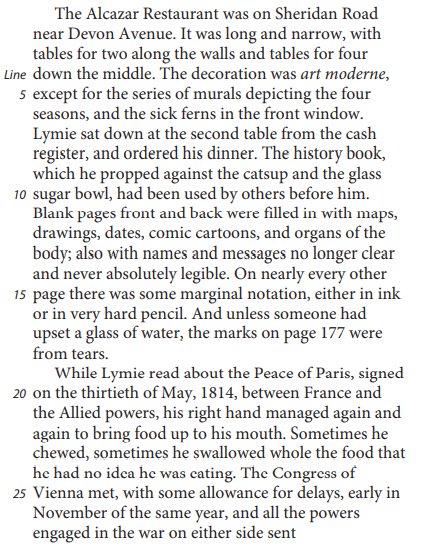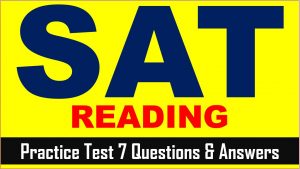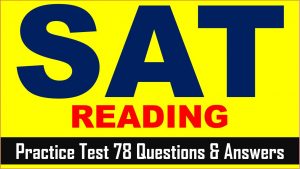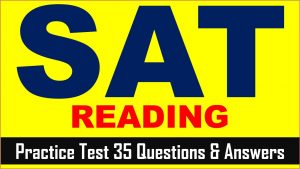SAT (Scholastic Assessment Test) is a standard test, used for taking admission to undergraduate programs of universities or colleges of the United States. SAT is developed and published by the College Board, an organization in the United States, administered by the Educational Testing Service. In this article of AKVTutorials, you will get Princeton Review 1400 Guarantee Book Review | Practice Test 21 AMBiPi.
The Princeton Review SAT Premium Prep Book
Before purchasing the Princeton Review for SAT Exam, there are following chapters in this book.
Check Price On Amazon
Table of Contents
Part 1: Orientation
- Chapter 1: The SAT, The Princeton Review, and You
- Chapter 2: Cracking the SAT: Basic Principles
Part 2: How to Crack the Reading Test
- Chapter 3: The Reading Test: Basic Approach
- Chapter 4: More Question Types
- Chapter 5: Advanced Reading Skills
- Chapter 6: Reading Drills
Part 3: How to Crack the Writing and Language Test
- Chapter 7: Introduction to Writing and Language Strategy
- Chapter 8: Words
- Chapter 9: Questions
- Chapter 10: Punctuation
Part 4: How to Crack the Math Test
- Chapter 11: SAT Math: The Big Picture
- Chapter 12: Fun with Fundamentals
- Chapter 13: Algebra: Cracking the System
- Chapter 14: Other Algebra Strategies
- Chapter 15: Advanced Arithmetic
- Chapter 16: Functions and Graphs
- Chapter 17: Geometry
- Chapter 18: Grid-Ins
Part 5: How to Crack the Essay
- Chapter 19: Reading and Analyzing the Essay Passage
- Chapter 20: Writing the Essay
Part 6: Taking the SAT
Part 7: Practice Tests
- Practice Test 1
- Practice Test 2
- Practice Test 3
- Practice Test 4
SAT Reading Practice Passage
This passage is adapted from William Maxwell, The Folded Leaf. ©1959 by William Maxwell. Originally published in 1945.
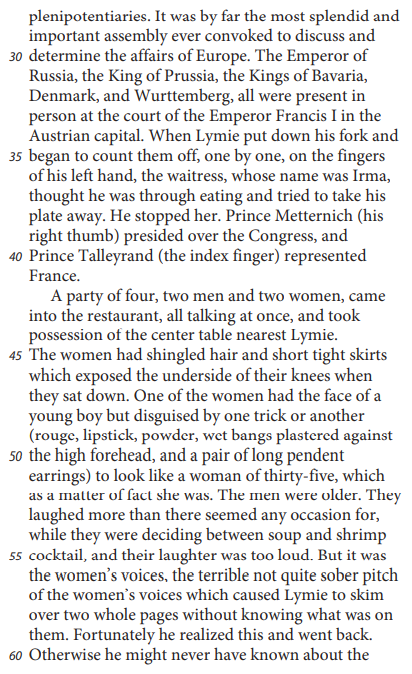
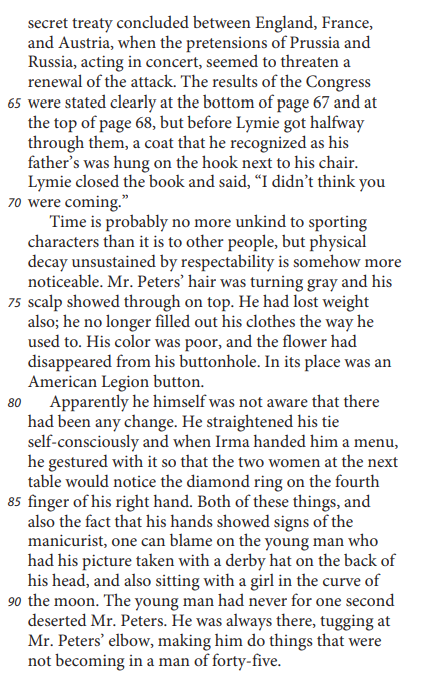
SAT Reading Comprehension Practice Test Questions
SAT Practice Test 21 Question No 1
Throughout the passage, the primary focus shifts from
Option A: Lymie’s inner thoughts to observations made by the other characters.
Option B: an exchange between strangers to a satisfying personal relationship.
Option C: the physical setting of the scene to the different characters’ personality traits.
Option D: Lymie’s experience reading a book to descriptions of people in the restaurant.
SAT Practice Test 21 Answer No 1
Show/Hide Answer
Option D :
The passage begins with the main character, Lymie, sitting in a restaurant and reading a history book. The first paragraph describes the book in front of him (“Blank pages front and back were filled in with maps, drawings, dates, comic cartoons, and organs of the body,” lines 11- 13). The second paragraph reveals what Lymie is reading about (the Peace of Paris and the Congress of Vienna) and suggests his intense concentration on the book (“sometimes he swallowed whole the food that he had no idea he was eating,” lines 23-24). In the third paragraph, the focus of the passage shifts to a description and discussion of others in the restaurant, namely “A party of four, two men and two women . . . ” (lines 42-43).
Choice A is incorrect because the passage does not provide observations made by other characters, only offering Lymie’s and the narrator’s observations. Choice B is incorrect because the beginning of the passage focuses on Lymie as he reads by himself and the end of the passage focuses on the arrival of Lymie’s father, with whom Lymie’s relationship seems somewhat strained. Choice C is incorrect because the setting is described at the beginning of the first paragraph but is never the main focus of the passage.
SAT Practice Test 21 Question No 2
The main purpose of the first paragraph is to
Option A: introduce the passage’s main character by showing his nightly habits.
Option B: indicate the date the passage takes place by presenting period details.
Option C: convey the passage’s setting by describing a place and an object.
Option D: foreshadow an event that is described in detail later in the passage.
SAT Practice Test 21 Answer No 2
Show/Hide Answer
Option C :
The main purpose of the first paragraph is to establish the passage’s setting by describing a place and an object. The place is the Alcazar Restaurant, which is described as being “long and narrow” and decorated with “art moderne,” murals, and plants (lines 2-6), and the object is the history book Lymie is reading.
Choice A is incorrect because rather than establishing what Lymie does every night, the first paragraph describes what Lymie is doing on one night. Choice B is incorrect because nothing in the first paragraph indicates when the passage takes place, as the details provided (such as the restaurant and the book) are not specific to one era. Choice D is incorrect because nothing in the first paragraph foreshadows a later event.
SAT Practice Test 21 Question No 3
It can reasonably be inferred that Irma, the waitress, thinks Lymie is “through eating” (line 37) because
Option A: he has begun reading his book.
Option B: his plate is empty.
Option C: he is no longer holding his fork.
Option D: he has asked her to clear the table.
SAT Practice Test 21 Answer No 3
Show/Hide Answer
Option C :
The passage states that “when Lymie put down his fork and began to count . . . the waitress, whose name was Irma, thought he was through eating and tried to take his plate away” (lines 34-38). It is reasonable to assume that Irma thinks Lymie is finished eating because he is no longer holding his fork.
Choice A is incorrect because Lymie has already been reading his book while eating for some time before Irma thinks he is finished eating. Choice B is incorrect because the passage doesn’t state that Lymie’s plate is empty, and the fact that Lymie stops Irma from taking his plate suggests that it is not empty. Choice D is incorrect because the passage does not indicate that Lymie asks Irma to clear the table.
SAT Practice Test 21 Question No 4
Lymie’s primary impression of the “party of four” (line 42) is that they
Option A: are noisy and distracting.
Option B: are a refreshing change from the other customers.
Option C: resemble characters from his history book.
Option D: represent glamour and youth.
SAT Practice Test 21 Answer No 4
Show/Hide Answer
Option A :
The passage makes it clear that Lymie finds the party of four who enter the restaurant to be loud and bothersome, as their entrance means he is no longer able to concentrate on his book: “They laughed more than there seemed any occasion for . . . and their laughter was too loud. But it was the women’s voices . . . which caused Lymie to skim over two whole pages without knowing what was on them” (lines 52-59).
Choices B, C, and D are incorrect because lines 55-59 make clear that Lymie is annoyed by the party of four, not that he finds their presence refreshing (choice B), thinks they resemble the people he is reading about (choice C) or thinks they represent glamour and youth (choice D).
SAT Practice Test 21 Question No 5
Which choice provides the best evidence for the answer to the previous question?
Option A: Lines 45-47 (“The women… down”)
Option B: Lines 47-52 (“One… was”)
Option C: Lines 55-59 (“But… them”)
Option D: Line 69 (“Lymie… book”)
SAT Practice Test 21 Answer No 5
Show/Hide Answer
Option C :
The previous question asks about Lymie’s impression of the party of four who enter the restaurant, with the correct answer being that he finds them noisy and distracting. This is supported in lines 55-59: “But it was the women’s voices, the terrible not quite sober pitch of the women’s voices, which caused Lymie to skim over two whole pages without knowing what was on them.”
Choices A, B, and D are incorrect because the lines cited do not support the answer to the previous question about Lymie’s impression of the party of four who enter the restaurant. Rather than showing that Lymie finds the group of strangers noisy and distracting, the lines simply describe how two of the four people look (choices A and B) and indicate what Lymie does when his father joins him in the restaurant (choice D).
SAT Practice Test 21 Question No 6
The narrator indicates that Lymie finally closes the history book because
Option A: his father has joined him at the table.
Option B: the people at the other table are too disruptive.
Option C: he has finished the chapter about Congress.
Option D: he is preparing to leave the restaurant.
SAT Practice Test 21 Answer No 6
Show/Hide Answer
Option A :
In the passage, Lymie closes his book only after “a coat that he recognized as his father’s was hung on the hook next to his chair” (lines 67-68). It is Lymie’s father’s arrival that causes him to close the book.
Choices B, C, and D are incorrect because lines 67-70 of the passage establish that Lymie closes his book because his father has arrived, not that he does so because the party of four is too loud (choice B), because he has finished reading a section of the book (choice C), or because he is getting ready to leave (choice D).
SAT Practice Test 21 Question No 7
The primary impression created by the narrator’s description of Mr. Peters in lines 74-79 is that he is
Option A: healthy and fit.
Option B: angry and menacing.
Option C: nervous and hesitant.
Option D: aging and shriveled.
SAT Practice Test 21 Answer No 7
Show/Hide Answer
Option D :
In lines 74-79, the narrator describes Mr. Peters as “gray” and balding, noting that he has “lost weight” and his color is “poor.” This description suggests Mr. Peters is aging and losing strength and vigor.
Choices A, B, and C are incorrect because the description of Mr. Peters in lines 74-79 suggests he is a person who is wan and losing vitality, not someone who is healthy and in good shape (choice A), angry and intimidating (choice B), or emotionally anxious (choice C).
SAT Practice Test 21 Question No 8
The main idea of the last paragraph is that Mr. Peters
Option A: neglects to spend any time with his family members.
Option B: behaves as if he is a younger version of himself.
Option C: is very conscious of symbols of wealth and power.
Option D: is preoccupied with the knowledge that he is growing old.
SAT Practice Test 21 Answer No 8
Show/Hide Answer
Option B :
In the last paragraph of the passage, Mr. Peters is described as being unaware “that there had been any change” in his appearance since he was younger (lines 80-81). Later in the paragraph, the passage states that “the young man” Mr. Peters once was “had never for one second deserted” him (lines 90-91). The main idea of the last paragraph is that Mr. Peters still thinks of himself as young, or at least acts as if he is a younger version of himself.
Choice A is incorrect because Mr. Peters is spending time with Lymie, his son, and there is no indication that he generally does not spend time with his family. Choice C is incorrect because although there are brief mentions of a diamond ring and manicured fingers, the paragraph focuses on Mr. Peters’s overall appearance, not on his awareness of status symbols. Choice D is incorrect because the last paragraph clearly states that Mr. Peters is “not aware that there had been any change” and thinks of himself as young.
SAT Practice Test 21 Question No 9
Which choice best supports the conclusion that Mr. Peters wants to attract attention?
Option A: Lines 80-81 (“Apparently… change”)
Option B: Lines 81-85 (“He straightened… hand”)
Option C: Lines 90-91 (“The young…Mr. Peters”)
Option D: Lines 91-93 (“He was… forty-five”)
SAT Practice Test 21 Answer No 9
Show/Hide Answer
Option B :
In lines 81-85, Mr. Peters is described as having “straightened his tie self-consciously” and gestured with a menu “so that the two women at the next table would notice the diamond ring on the fourth finger of his right hand.” Mr. Peters’s actions are those of someone who wants to attract attention and be noticed.
Choices A, C, and D are incorrect because the lines cited do not support the idea Mr. Peters wants to attract attention to himself. Choices A and C address Mr. Peters’s view of himself. Choice D indicates that Mr. Peters’s view of himself affects his behavior but does not reveal that he acts in a way meant to draw attention.
SAT Practice Test 21 Question No 10
As used in line 93, “becoming” most nearly means
Option A: emerging.
Option B: fitting.
Option C: developing.
Option D: happening.
SAT Practice Test 21 Answer No 10
Show/Hide Answer
Option B :
The last sentence of the passage states that Mr. Peters’s mischaracterization of himself makes him act in ways that are not “becoming” for a man of his age. In this context, “becoming” suggests behavior that is appropriate or fitting.
Choices A, C, and D are incorrect because in the context of describing one’s behavior, “becoming” means appropriate or fitting, not becoming known (choice A), becoming more advanced (choice C), or simply occurring (choice D).


